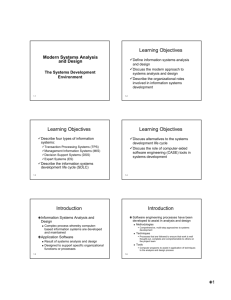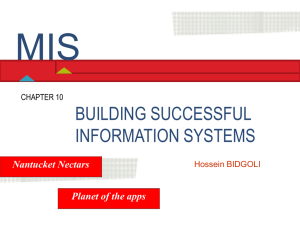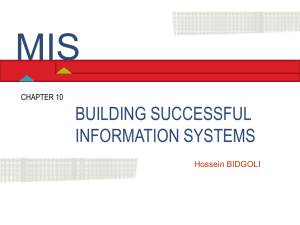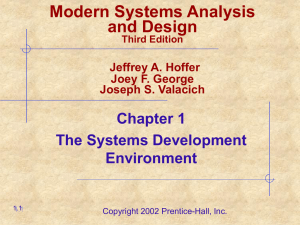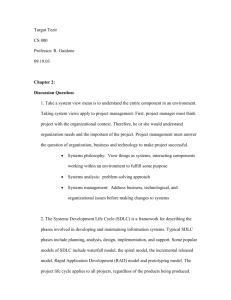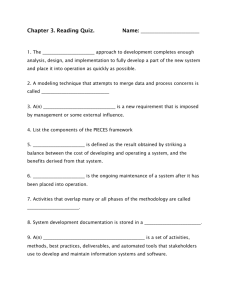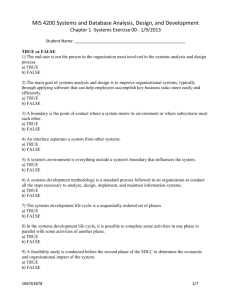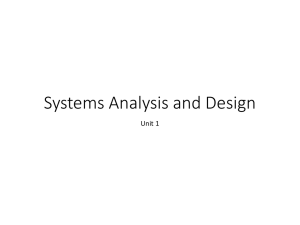Modern Systems Analysis and Design Joey F. George Jeffrey A
advertisement
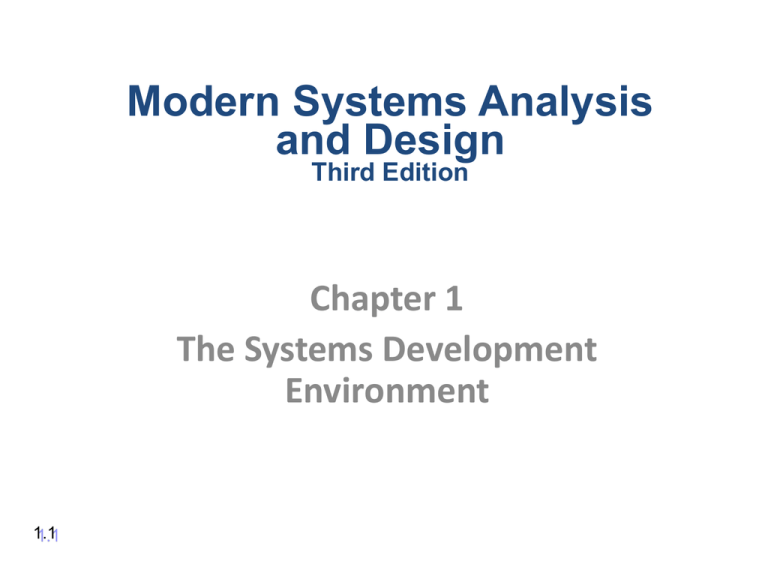
Modern Systems Analysis and Design Third Edition Chapter 1 The Systems Development Environment 1.1 Introduction • Information Systems Analysis and Design – Complex process whereby computer-based information systems are developed and maintained – Main goal is to improve employee efficiency by applying software solutions to key business tasks – A structured approach must be used in order to ensure success • Application Software – Result of systems analysis and design – Designed to support specific organizational functions or processes • Systems Analyst performs analysis and design based upon: – Understanding of organization’s objectives, structure and processes – Knowledge of how to exploit information technology for advantage 1.4 Software Engineering Process • A process used to create an information system • Consists of: – Methodologies • A sequence of step-by-step approaches that help develop the information system – Techniques • Processes that the analyst follows to ensure thorough, complete and comprehensive analysis and design – Tools • Computer programs that aid in applying techniques 1.7 Data and Processes • Three key components of an information system – Data – Data Flows – Processing Logic • Data vs. Information – Data • Raw facts about people, objects, and events in an organization such as customer’s account number – Information • Data that have been processed and presented in a form that humans can understand 1.4 Data and Processes • Data – Understanding the source and kind of data a system uses is key to good system design – Various techniques are used to describe data and the relationship among data • Data Flow – Groups of data that move and flow through the system from one place to another – Include description of sources and destination for each data flow • Processing Logic – Describe steps in the transformation of data and events that trigger these steps 1.5 Approaches to Systems Development • Process-Oriented Approach – Focus is on how and when data are moved and transformation of data in an information system – Involves creating graphical representations such as data flow diagrams and charts – Data are tracked from sources, through intermediate steps and to final destinations – Natural structure of data is not specified – Disadvantage: existence of several data files each locked within different applications. – To change a single data element all files has to be updated 1.6 Approaches to Systems Development • Data-Oriented Approach – Depicts ideal organization of data, independent of where and how data are used – Data model describes kinds of data and business relationships among the data – Business rules depict how organization captures and processes the data 1.7 Databases and Application Independence • Database – Shared collection of logically related data – Organized to facilitate capture, storage and retrieval by multiple users in an organization – Centrally managed – Designed around subjects • Customers • Suppliers • Application Independence – Separation of data and definition of data from applications that use these data 1.8 Organizational Responsibilities in Systems Development • Systems development is a team effort • Systems Analysts work in a team – Project Based – Includes • IS Manager • Programmers • Users • Other specialists – Characteristics of Successful Teams • Diversity of backgrounds • Tolerance of diversity • Clear and complete communication • Trust • Mutual Respect • Reward structure that promotes shared responsibility 1.9 Organizational Responsibilities in Systems Development • IS Manager – May have a direct role in systems development if the organization is small – Typically involved in allocating resources to and overseeing system development projects. – May prescribe what methodologies, techniques and tools to be used • Systems Analyst – Key individuals in the systems development process Organizational Responsibilities in Systems Development • Skills of a Successful Systems Analyst – Analytical • Understanding of organizations • Problem solving skills • System thinking – Ability to see organizations and information systems as systems – Technical • Understanding of potential and limitations of technology – Management • Ability to manage projects, resources, risk and change – Interpersonal • Effective written and oral communication skills 1.11 Organizational Responsibilities in Systems Development • Programmers – Convert specifications into instructions that the computer understands – Write program documentation and programs for testing systems • Business Managers – Have power to fund projects and allocate resources – Set general requirements and constraints for projects 1.12 Organizational Responsibilities in Systems Development • Other IS Managers / Technicians – Database Administrator • Involved in design, development and maintenance of databases – Network and telecommunications experts • Develop systems involving data and/or voice communications – Human Factors Specialists • Involved in training users and writing documentation – Internal Auditors • Ensure that required controls are built into the system 1.13 Types of Information Systems and Systems Development • Transaction Processing Systems (TPS) – Automate handling of data about business activities (transactions) • Management Information Systems (MIS) – Converts raw data from transaction processing system into meaningful form • Decision Support Systems (DSS) – Composed of database designed to help decision makers – Provides interactive environment for decision makers to manipulate data and models • Expert Systems (ES) – Codifies and manipulate knowledge instead of information – Users communicate with an ES through interactive dialogue 1.14 Systems Development Life Cycle • System Development Methodology – Standard process followed in an organization – Consists of: – Analysis – Design – Implementation – Maintenance of information systems 1.15 Systems Development Life Cycle (SDLC) • SDLC – traditional methodology used to develop, maintain, and replace information systems • Consists of six phases: – – – – – – 1.16 Project Identification and Selection Project Initiation and Planning Analysis Design Implementation Maintenance Systems Development Life Cycle – Phases are not necessarily sequential – Each phase has a specific outcome and deliverable – It is possible to complete some activities in one phase in parallel with some activities of another phase – Sometimes life cycle is iterative – phases are repeated as required until acceptable system is found – Sometimes life cycle is spiral – constantly cycle through the phases at different levels – Individual companies use customized life cycles 1.17 spiral life cycle Phases of the Systems Development Life Cycle • Project Identification and Selection – Two Main Activities • Identify and analyze organizations information system needs • Prioritization and translation of need into a development schedule – Helps organization to determine whether or not resources should be dedicated to a project. • Project Initiation and Planning – Two Activities • Formal preliminary investigation of the problem at hand • Presentation of reasons why system should or should not be developed by the organization – Determining scope of the proposed system 1.19 Systems Development Life Cycle • Analysis – Study of current procedures and information systems – Sub phases • Determine requirements – Study current system – Structure requirements and eliminate redundancies • Generate alternative designs • Compare alternatives • Recommend best alternative 1.20 Systems Development Life Cycle • Design – convert the description into logical and then physical system specifications – Logical Design • Concentrates on business aspects of the system • Independent of any specific hardware or software platform – Physical Design • Logical specifications are transformed into technical specifications 1.21 Systems Development Life Cycle • Implementation – Information system is • Coded – programmers write programs • Tested – programmers and analysts test individual programs and entire system to find errors and correct • Installed – application software is installed on hardware • Supported – documentation and training programs are provided • Maintenance – Information system is systematically repaired and improved depending on organization’s needs over time – Programmers modify the system to reflect changing business conditions – It is a repetition of other life cycle phases and is not a separate phase 1.22 Approaches to Development • Prototyping – Designing and Building a scaled-down working version of the system with any computer language (4GLs) or development tools (CASE) – Advantages: • Users are involved in design • Captures requirements in concrete form - Prototyping is a form of rapid application development • Rapid Application Development (RAD) 1.23 – Utilizes prototyping to delay producing system design until after user requirements are clear Approaches to Development • Joint Application Design (JAD) – Users, Managers and Analysts work together for several days in a series of intensive meetings – System requirements are reviewed 1.24
